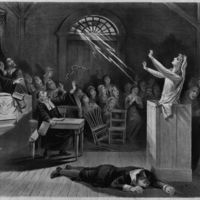Browse Exhibits (1 total)
Salem Witch Trials

Few events in American history were as strange and unjustified as the seventeenth century Salem Witch Trials. After exploring the circumstances surrounding the trials, we concluded that the hysteria stemmed from a social discrimination of women and outcasts fueled by the superstitious Puritan ideology at the time. From February 1692 through September 1693, hundreds of accused witches were killed, the majority of which were servants, debtors, slaves, or elderly and unwanted (Brandt). These trials and executions were supported by an unfair legal system that was based on spectral evidence and social status. While the trials seem completely ridiculous from a modern point of view, an analysis of the social climate of seventeenth century Massachusetts brings light to how the Salem Witch Trials occurred. Through our collection of items, we hope to illustrate the social, legal, and monumental aspects of this unusual event that has branded Salem, Massachusetts. The social climate of Salem, Massachusetts was characterized by strict adherence to Puritan beliefs and superstitions. Their widespread use of witchcraft to explain anything strange or uncustomary led to the unfair trials. With no way of presenting concrete evidence, the accused witches were charged on account of spectral evidence, leading to the execution of the innocent. By combining sources from the seventeenth century with modern day research, we were able to analyze an unusual colonial event with a modern, progressive lens.